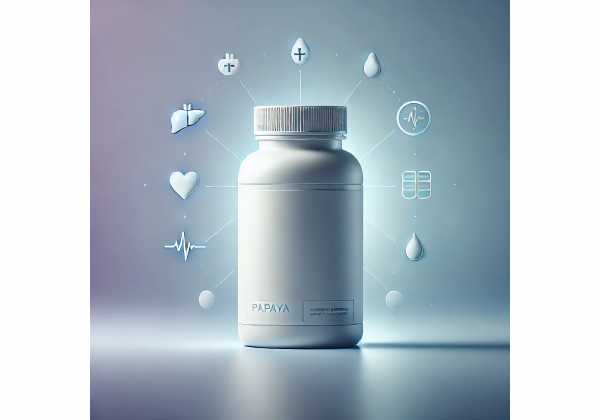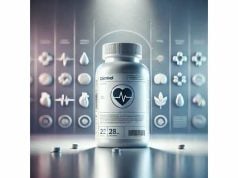
Fermented papaya—often labeled Fermented Papaya Preparation (FPP)—is a powdered nutraceutical made by fermenting ripe Carica papaya pulp with selected microbes, then drying it into convenient sachets. Unlike raw papaya or papaya leaf extracts, FPP is standardized for antioxidant capacity and used primarily to counter oxidative stress, support immune function, and help maintain healthy inflammatory balance. Early clinical studies suggest daily use may lower markers of DNA oxidative damage and restore certain age-related immune declines. Most products provide 3 g per sachet, typically taken two or three times per day, and are well tolerated by many adults. Still, “natural” doesn’t mean risk-free: people with latex–papaya cross-allergy, pregnant individuals, and those with complex medical conditions should speak with a clinician first. Below, you’ll find a balanced, evidence-guided guide to what FPP is, how it’s used, how much to take, who it may help, and safety details to consider.
Fast Facts
- May reduce oxidative stress markers and support immune cell activity in older adults; evidence remains preliminary.
- Typical dosing in studies: 6–9 g/day total, often 3 g taken 2–3 times daily for 4–24 weeks.
- Safety caveat: avoid if you have papaya or latex allergy; stop and seek care if rash, wheeze, or swelling occur.
- Best avoided by pregnant or breastfeeding individuals and those with complex multimorbidity unless a clinician agrees.
Table of Contents
- What is fermented papaya?
- Does it work and what are the benefits?
- How to take it and typical dosage
- Who might benefit and when to use it
- Side effects, risks, and who should avoid it
- Research quality: what the evidence really shows
What is fermented papaya?
Fermented papaya is a standardized powder created from ripe Carica papaya fruit that’s mashed, inoculated with specific microorganisms, and allowed to ferment under controlled conditions. The mash is then dried to yield a shelf-stable powder—typically packed in 3-gram sachets—commonly referred to as FPP (Fermented Papaya Preparation). You may also see legacy brand names in the scientific literature. While some papaya supplements focus on leaf or seed extracts, FPP is made from the fruit pulp and transformed by fermentation.
Why ferment papaya at all? Fermentation is a biochemical “pre-processing” step. It can:
- Modify polyphenols and sugars into smaller, more bioactive metabolites.
- Increase antioxidant potential, measured in vitro by assays such as ORAC or by downstream effects on oxidative biomarkers.
- Reduce variability in raw plant material by using a controlled, repeatable process.
Chemically, FPP contains a mix of carotenoids, phenolic acids, flavonoids, organic acids, and Maillard reaction products formed during fermentation. Human and preclinical studies suggest these compounds may quench reactive oxygen species (ROS), help maintain glutathione balance, and influence immune signaling (for example, NK-cell or PBMC cytolytic activity). In practical terms, users and clinicians consider FPP when oxidative stress is a shared mechanism—healthy aging, metabolic dysregulation, and recovery from illness all feature oxidative strain.
It’s vital to distinguish FPP from:
- Raw papaya fruit (food): nutritious, but not the same standardized, fermented composition.
- Papaya leaf preparations: popular in dengue research and distinct in bioactives (alkaloids, glycosides, etc.).
- Papain enzymes: sometimes marketed for digestion; FPP is not simply an enzyme product.
Quality varies. Reputable products document origin of papaya, fermentation strain/method, lot-to-lot testing, and sometimes assays of antioxidant capacity. Because nutraceutical regulations differ by country, choose manufacturers that publish data or provide certificates of analysis on request.
Finally, remember that FPP is a supportive nutraceutical, not a disease cure. The best outcomes appear when it’s paired with core health practices: balanced diet, movement, sleep, and condition-specific medical care.
Does it work and what are the benefits?
The most consistent signals for fermented papaya in humans center on oxidative stress reduction and select immune effects—with the caveat that most trials are small, often single-center, and sometimes industry-supported.
Oxidative stress and DNA damage. In a randomized, placebo-controlled crossover study in healthy older adults, daily FPP reduced markers linked to oxidative DNA damage (such as 8-hydroxy-2′-deoxyguanosine, often abbreviated 8-OHdG) compared with placebo. This aligns with the mechanistic rationale: fermentation-derived antioxidants can neutralize ROS or improve redox enzyme systems. While reductions in an oxidative biomarker don’t automatically translate to hard clinical endpoints, they do indicate biological activity in humans.
Immune support (age-related). In tube-fed older patients—a population prone to immune senescence—FPP at 9 g/day restored the cytolytic activity of peripheral blood mononuclear cells (PBMCs). Notably, the same trial explored shifts in the gut microbiota (reduced abundance of certain Firmicutes taxa), hinting at a microbiome-immune axis contribution. These findings are narrow (specific outcomes in a vulnerable group), but they suggest FPP may help rebalance immune function in contexts of age-related decline.
Inflammation and endothelial hints. Other interventional work (including longer studies in middle-aged and older adults) has tracked changes in redox/immune markers such as neutrophil-to-lymphocyte ratio (NLR), asymmetric dimethylarginine (ADMA), and urinary 8-OHdG over months of supplementation. Some measures improved, while others were unchanged or showed high variability, reinforcing a cautious takeaway: signal is present, but not uniform across endpoints.
What fermented papaya is not. The evidence does not support FPP as a stand-alone treatment for specific diseases (e.g., dementia, diabetes, infections). Trials are not powered or designed for hard outcomes such as mortality, hospitalization, or disease remission. Where FPP shows promise, it is as a complement to standard care to lower oxidative strain and fine-tune immune function.
Who notices benefits most? Patterns across studies suggest greater effect sizes in older adults and in individuals with higher baseline oxidative stress. Healthy young populations may see smaller, harder-to-detect benefits.
How quickly? Biomarker shifts (like 8-OHdG or certain immune activity readouts) have been observed within weeks, but sustained changes often require 8–24 weeks of regular use.
Bottom line: FPP appears to lower oxidative stress markers and modestly support immune cell function in select adult groups. The current research base is encouraging but preliminary—use it as part of a broader plan, not as a replacement for proven therapy.
How to take it and typical dosage
Standard dose used in studies:
Most human studies use a total daily dose of 6–9 grams, commonly delivered as 3-gram sachets taken two or three times daily (e.g., morning and evening, or before the three main meals). That daily amount has been used for 4 to 24 weeks, and in some protocols, longer.
Practical routine (example):
- Start at 3 g twice daily (total 6 g/day) for 1–2 weeks to assess tolerance.
- If well tolerated and your clinician agrees, increase to 9 g/day (3 g, three times daily) for 8–12 weeks.
- Reassess: if your goal is biomarker improvement (e.g., oxidative stress lab markers ordered by your clinician), retest after 8–12 weeks of consistent use.
- Maintenance: many users continue at 3–6 g/day, or cycle 8–12 weeks on / 4 weeks off. There’s no universal schedule; align the plan with clinical goals and seasonality (e.g., during periods of higher physiological stress).
With or without food?
Most products are taken on a light stomach or before meals; some protocols have participants let the granules dissolve slowly on the tongue then swallow. If you experience mild stomach upset, take with a small snack and adequate water.
Combining with other supplements.
Because FPP targets oxidative and immune pathways, avoid redundant mega-antioxidant stacks unless guided by a professional; extremely high antioxidant dosing can sometimes blunt training adaptations in athletes or interfere with hormesis. Pairing FPP with a quality multivitamin, omega-3s, or probiotics is common, but individualize choices.
Quality checklist when buying:
- Transparent labeling of dose per sachet (commonly 3 g), serving suggestions, and batch/lot number.
- Evidence of standardization (e.g., validated process, in-house or third-party testing for contaminants and composition).
- Clear storage instructions (cool, dry place; avoid humidity).
- Reputable manufacturer with published human data or robust quality documentation.
When to stop or adjust:
- Allergic symptoms (hives, swelling, wheeze): discontinue immediately and seek care.
- New medications or procedures: pause and confirm compatibility, especially before surgery or if anticoagulation status changes.
- Pregnancy or breastfeeding: avoid unless your obstetric clinician explicitly recommends use.
Special populations:
Older adults, those with metabolic risk, or people under higher oxidative stress (e.g., intensive training blocks, recovery periods) are typical FPP users in studies. Individuals with autoimmune disease or on immunomodulating drugs should consult their specialist before use.
Storage and handling:
FPP draws moisture; keep sachets sealed until use. If a sachet clumps from humidity, discard rather than guessing potency.
Who might benefit and when to use it
Likely candidates (based on studied contexts):
- Healthy older adults seeking support for redox balance and immune robustness. Aging is accompanied by higher basal inflammation and oxidative stress; FPP has shown biomarker improvements in these groups.
- Adults with lifestyle-related oxidative strain—e.g., poor sleep, high psychosocial stress, air pollution exposure—looking for adjunctive antioxidant support while they fix root causes.
- Individuals in recovery (e.g., after illness) under professional supervision, particularly where maintaining immune competence and controlling oxidative stress are priorities.
- Select athletes during intensified training blocks who wish to support redox homeostasis. Caution: excessive antioxidant stacking may blunt training adaptations; prioritize food-first strategies.
Situations where FPP is less likely to help:
- As a sole therapy for medical conditions that require standard treatments (e.g., infections, endocrine disorders, autoimmune flares).
- In young, healthy adults with low oxidative burden, where measurable benefits may be marginal.
- When basic pillars (diet quality, sleep, movement) are unaddressed; nutraceuticals can’t compensate for major lifestyle gaps.
How to integrate FPP into a broader plan:
- Measure what matters. If feasible, anchor use to objective markers (lipids, hs-CRP, or clinician-ordered oxidative stress panels). This allows a trial-off period if you see no benefit after 8–12 weeks.
- Stack wisely. Combine with whole-food sources of antioxidants (berries, leafy greens, nuts, legumes) and protein for recovery. Avoid megadoses of overlapping antioxidants without rationale.
- Timing. Many users prefer morning and early evening dosing. If you’re sensitive to supplements at night, keep the last dose at least 3–4 hours before bedtime.
Realistic expectations:
- Feel: most users won’t notice a “kick.” Benefits, if they occur, are subtle—less fatigue during stress, better training tolerance, or improved lab markers.
- Time horizon: expect weeks, not days, before judging benefit.
- Plateaus can happen. Cycling (e.g., 8–12 weeks on, 4 weeks off) may prevent tolerance and simplifies attribution when you reassess.
When to choose alternatives instead:
- If your goal is lipid management or glycemic control, prioritize diet, exercise, sleep, and medications with proven outcomes; consider berberine, soluble fiber, or omega-3s based on clinician advice.
- If your issue is iron deficiency or thyroid dysfunction, FPP is not a substitute for iron repletion or thyroid hormone—consider addressing the primary deficit first.
Cost–benefit framing:
Because FPP is often a premium supplement, align its use with periods where oxidative/immune support is most justified: seasonal stress, training peaks, or defined recovery windows. If cost is a barrier, a whole-food antioxidant pattern plus sleep hygiene outruns most pills.
Side effects, risks, and who should avoid it
Typical tolerability. At 6–9 g/day, FPP is generally well tolerated in small trials and observational use. The most common minor complaints are mild gastrointestinal symptoms (bloating, upset stomach) that often resolve by taking with a light snack or reducing the dose.
Allergy considerations.
- Papaya allergy can trigger skin, respiratory, or systemic reactions. If you’ve reacted to papaya fruit, avoid FPP.
- Latex–fruit syndrome: Cross-reactivity between latex and papaya has been reported. People with latex allergy are at higher risk for reactions to papaya derivatives. If you have latex allergy (or multi-fruit latex syndrome), avoid FPP unless an allergist clears its use.
Enzyme/adjuvant concerns. Papaya contains papain-like cysteine proteases. While FPP isn’t sold as a papain tablet, background exposure to papain-family proteins has been implicated in allergenicity in sensitized individuals. If you have a history of protease enzyme reactions (e.g., papain, bromelain), proceed cautiously and discuss with your clinician.
Pregnancy and breastfeeding.
Human data on oral fermented papaya in pregnancy or lactation are insufficient. Because raw papaya latex and certain papaya parts raise theoretical concerns, it’s prudent to avoid FPP during pregnancy/breastfeeding unless your obstetric clinician specifically recommends it for a clear indication.
Medical conditions and interactions.
- Autoimmune disease / immunotherapy: Because FPP may modulate immune signaling, coordinate with your specialist if you’re on biologics or immunosuppressants.
- Perioperative care: Pause supplements 1–2 weeks before surgery unless your surgical team advises otherwise.
- Diabetes, anticoagulation, thyroid disorders: Evidence for direct interactions is limited; however, because FPP can influence oxidative and inflammatory pathways, monitor clinically relevant markers (glucose, INR if applicable, thyroid labs) when adding or removing it from your regimen.
When to stop and seek help immediately:
- Hives, swelling of lips/tongue, difficulty breathing, severe dizziness.
- Persistent GI distress, vomiting, or diarrhea that doesn’t settle with dose reduction.
- New rash or unusual bleeding/bruising.
Quality and contamination risks. Choose vendors who test for heavy metals, microbes, and common adulterants. Third-party seals are helpful but not a guarantee; independent batch test reports are better.
Driving and cognition. FPP doesn’t typically impair alertness. If you feel unusually fatigued or foggy after dosing, stop and reassess with your clinician.
Summary: Most adults tolerate 6–9 g/day of FPP without major issues, but people with papaya/latex allergy, those who are pregnant or breastfeeding, and anyone on complex immunotherapy should avoid or use only under medical supervision.
Research quality: what the evidence really shows
What’s strong:
- Biological plausibility: Fermentation enhances antioxidant potential and yields small molecules that can affect redox and immune pathways.
- Human biomarker effects: Multiple trials, though small, report reductions in oxidative DNA damage markers and improvements in PBMC cytolytic activity at ~9 g/day over weeks to months.
What’s limited or uncertain:
- Clinical endpoints: There are few or no large, multi-center RCTs with hard outcomes (e.g., hospitalization, incident disease). Most studies focus on intermediate biomarkers.
- Population breadth: Many studies involve older adults or specific clinical contexts; generalizability to diverse populations is uncertain.
- Durability: We have limited data on long-term maintenance, dose tapering, or benefits beyond 6–12 months (some longer studies exist but with mixed endpoints).
- Funding and bias: Some investigations are industry-supported or conducted by labs associated with the product’s origin, which increases potential for bias. Independent replication is needed.
Typical study designs and doses:
- Randomized, placebo-controlled crossover trials in healthy older adults using 9 g/day have shown oxidative stress marker improvements over months.
- Interventional studies in tube-fed elderly at 9 g/day demonstrated PBMC cytolytic activity restoration and microbiota shifts.
- Longer double-blind studies in middle-aged/elderly cohorts have tracked changes in NLR, ADMA, and 8-OHdG, with some favorable trends.
How to interpret the mixed landscape:
- Treat FPP as a targeted adjunct—useful for redox balance and selective immune support, especially in older or higher-stress groups—rather than as a primary therapy.
- Expect small-to-moderate effects on biomarkers, not dramatic clinical transformations.
- Prioritize clinician-guided monitoring if you’re using FPP for a health goal; this keeps expectations aligned with measurable outcomes.
Key take-home: The evidence base for fermented papaya is promising but not definitive. If you choose to use it, do so intentionally: reasonable dose (6–9 g/day), defined trial window (8–12 weeks), and a plan to continue only if objective or subjective benefit is clear.
References
- Nutraceutical supplementation: effect of a fermented papaya preparation on redox status and DNA damage in healthy elderly individuals and relationship with GSTM1 genotype: a randomized, placebo-controlled, cross-over study 2006 (RCT)
- Fermented Papaya Preparation Restores Age-Related Reductions in Peripheral Blood Mononuclear Cell Cytolytic Activity in Tube-Fed Patients 2017 (Clinical Study)
- Benefits of Fermented Papaya in Human Health 2022 (Systematic Review)
- Plant and Arthropod IgE-Binding Papain-like Cysteine Proteases: Multiple Contributions to Allergenicity 2024 (Review)
- Phytomedical Properties of Carica papaya for Boosting Human Immunity Against Viral Infections 2025 (Review)
Disclaimer
This article is for educational purposes only and does not replace personalized medical advice, diagnosis, or treatment. Fermented papaya is not a cure for any disease. Always consult a qualified healthcare professional before starting, stopping, or combining supplements—especially if you are pregnant or breastfeeding, have allergies (including latex), take prescription medications, or manage chronic conditions.
If you found this guide helpful, consider sharing it on Facebook, X (formerly Twitter), or your preferred platform, and follow us for future evidence-based wellness content. Your support helps us continue creating high-quality, people-first articles.










